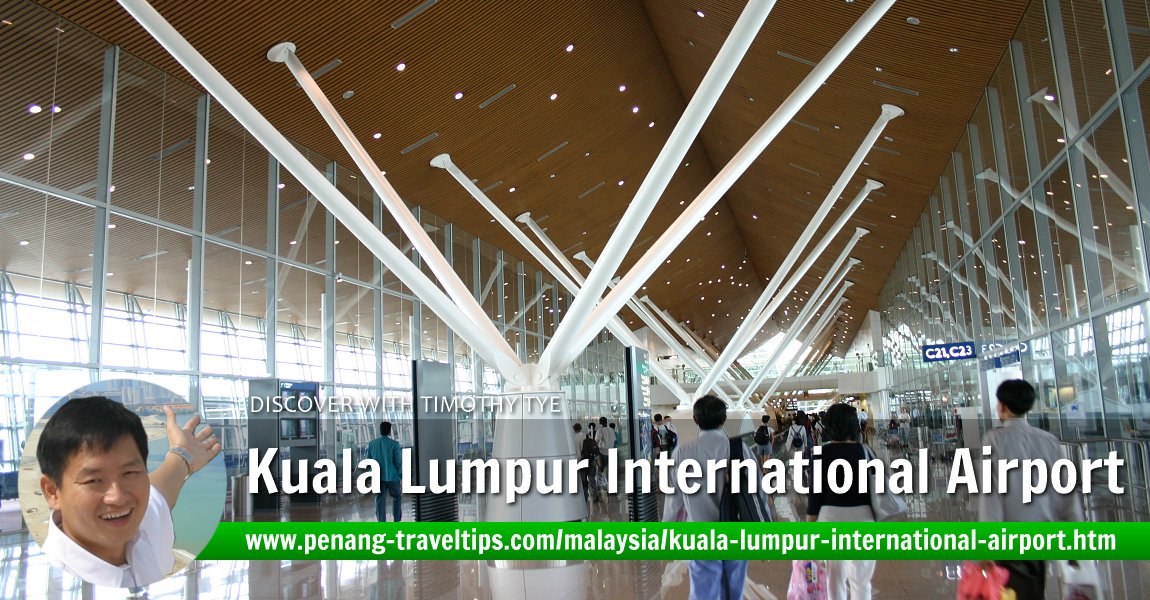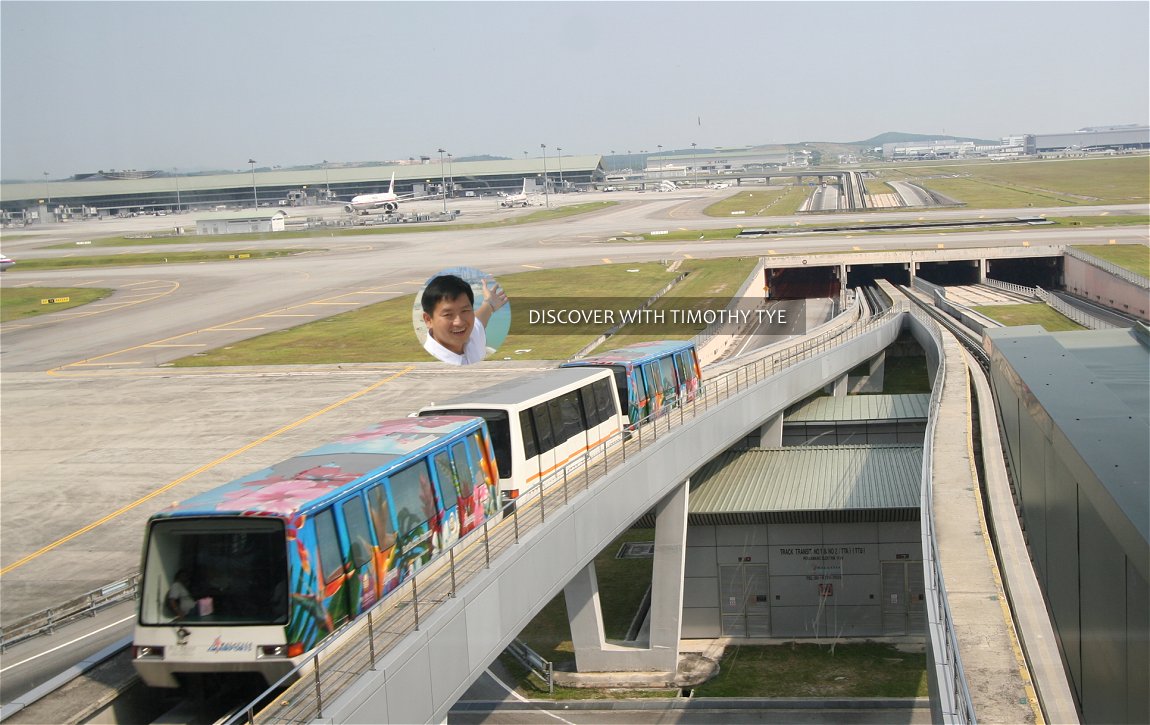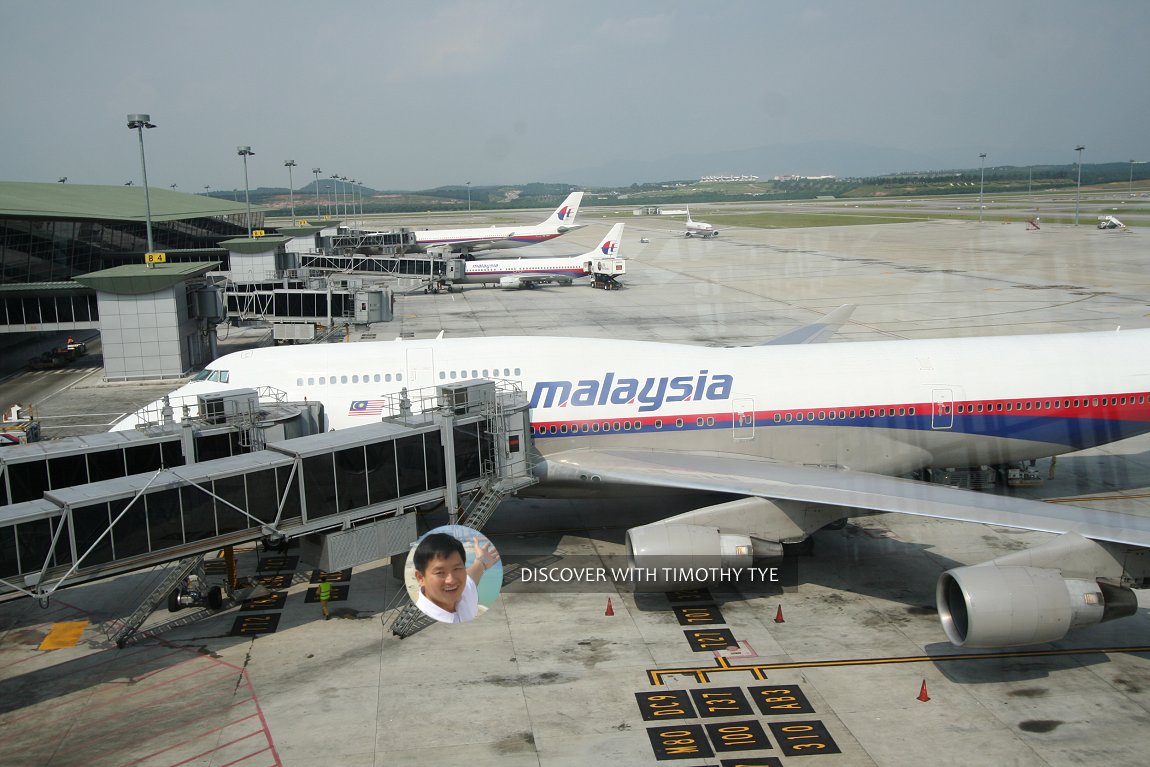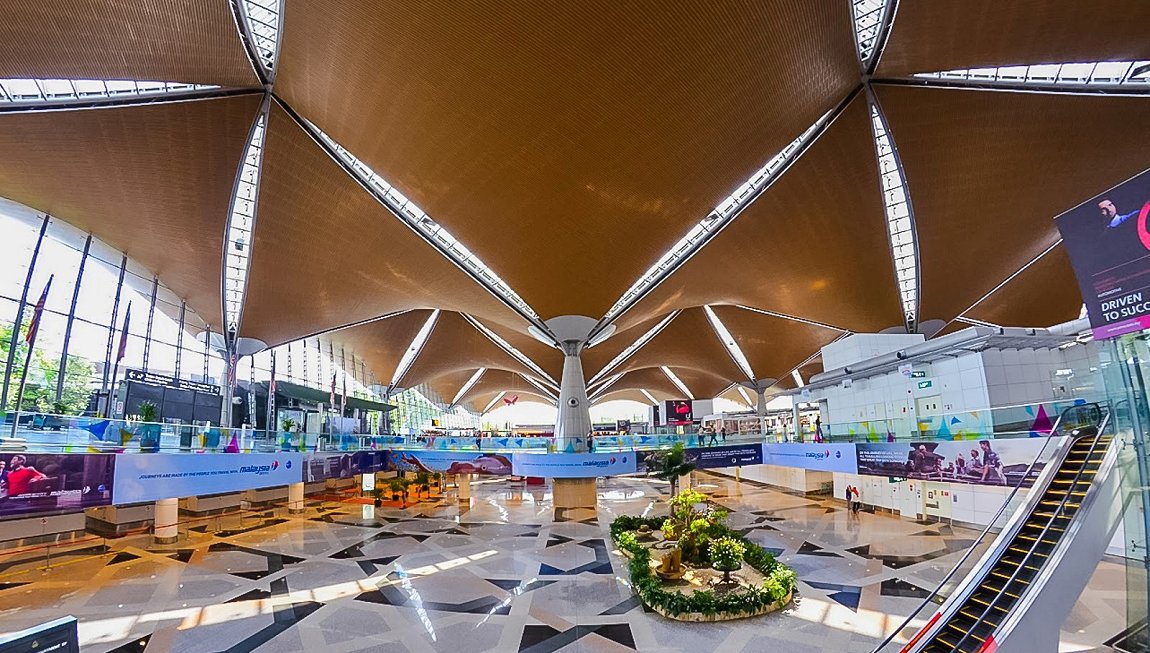
 Kuala Lumpur International Airport (30 November, 2003)
Kuala Lumpur International Airport (30 November, 2003)
Kuala Lumpur International Airport (KUL), (GPS: 2.75452, 101.70431), popularly known as KLIA, is the airport serving Kuala Lumpur, and is the main gateway to Malaysia. It is located in Sepang district in Selangor, some 60 km from Kuala Lumpur. It comprises a main terminal, a satellite terminal, and KLIA2, the low-cost carrier terminal. The main terminal building also serves as the domestic terminal. The satellite terminal handles international flights while the LCCT, presently used by AirAsia, Tiger Airways and Cebu Pacific, handles the low-cost flights by budget airlines. The airport was built at a cost of US$3.5 billion. It opened in 1998 replacing the old Subang International Airport, which was later renamed the Sultan Abdul Aziz Shah Airport.
About the Kuala Lumpur International Airport
In its current phase, KLIA is capable of handling 35 million passengers and 1.2 million tonnes of cargo a year. As of 2007, it is the 13th busiest airport in terms of international passenger traffic, and the 7th busiest international airport in Asia. It handled 27 million passengers that year. The airport is operated by Malaysia Airports, and is the home base for Malaysia Airlines, MASkargo, AirAsia and AirAsia X.Sited on an area spanning 100 sq km, KLIA is one of the largest airport sites in the world. It is built on agricultural land and required no demolition of private property. The master plan of Kuala Lumpur International Airport involves constructing five runways, and two terminals accompanied by two satellite terminals for each terminal over three phases.
Phase One development includes constructing one main terminal accompanied by one satellite terminal that is enough to accommodate 25 million passengers and dual full service runways. Under the implementation of Phase One, sixty contact piers, twenty remote parking bays with eighty aircraft parking positions, four maintenance hangars and fire stations will be built. Implementation of phase two and three will be expansions of the airport to include increasing number of passengers. Ultimately, KLIA will be able to handle 100 million passengers per annum once all three phases are implemented.
Kuala Lumpur International Airport Terminal 1 is  on the map of Airports of Malaysia
on the map of Airports of Malaysia
The rest of this article deals with arriving at KLIA main terminal. If you are arriving at KLIA2, the low-cost carrier terminal, please click on link below.
Arriving at KLIA2 low-cost carrier terminal
DetailsFinding your way upon arriving at KLIA
Still, it's quite straight forward if you are simply exiting the airport for Kuala Lumpur. If you arrive at the Satellite Building, take the Aerotrain to the Main Building. Then follow the signage to go through immigration, collect your baggage at the carousel, go through Customs, through the green lane if you have nothing to declare, and you are at the Arrival Hall. It's even simpler if you arrived on domestic flight at the Main Building. Just collect your baggage and out the door to the Arrival Hall. If you're arriving at the LCCT, it is similar: walk on the tarmac to the LCCT Arrival Hall, and out the door. Aerotrain arriving (1 March 2006)
Aerotrain arriving (1 March 2006)
 The Contact Piers at KLIA (1 March 2006)
The Contact Piers at KLIA (1 March 2006)
Getting out of KLIA
By Train
There are two train options to choose: KLIA Express and KLIA Transit. Both are the same type on trains on the same tracks, the only difference being KLIA Express takes you directly to KL Sentral in the city centre, while KLIA Transit makes a few stops, at Salak Tinggi, Putrajaya and Bandar Tasik Selatan. KLIA EkspresThe KLIA Ekspres is a direct non-stop high-speed train that connects KLIA to the KL Sentral transportation hub in the centre of Kuala Lumpur. The journey takes 28 minutes and costs RM35 per way. The service runs from 5:00 am to 12:00 midnight. There's a train every 15 minutes between 5:00 am to 9:00 am, and from 4:00 pm to 10:00 pm, and every 20 minutes outside these hours.
KLIA Transit
The KLIA Transit is similar to KLIA Ekspres except it makes three stops, at Salak Tinggi, Putrajaya and Bandar Tasik Selatan, hence travel time to Kuala Lumpur is 36 minutes. The fare is also RM35 to KL Sental, and other fares are charged for journeys to the other stations. The trains run every half hour from 5:33 am to 12:03 am.
By Bus
The Airport Coach operates an hourly express bus between KLIA and KL Sentral from 6:30 am to 12:30 am. The fare is RM10 one way and RM18 return. Star Shuttle bus runs from KLIA to Kota Raya and Pudu Raya (both are near the Chinatown), RM10 one way. Sepang Omnibus runs local bus services directly to Seremban in Negeri Sembilan, Banting in Selangor and Sepang town where you can get connecting buses to/from Port Dickson, Negeri Sembilan. The buses are a little basic and uncomfortable, and do not follow a timetable (at least, not one that is publicly known). Both Airport Coach and Sepang Omnibus run frequent buses between KLIA and Nilai where you continue your journey on the KTM Komuter.By Taxi
If you wish to take a taxi out of KLIA, rely only on the Airport Limousine Taxis, not on the touts what may approach you at the Arrival Hall - many tourists have been fleeced with outrageous fares from touts, and you do not wish to start your visit to Kuala Lumpur on a sour note. Buy the taxi coupon from the Airport Limo counter. If you ask for a "Budget Taxi" you are charged a fixed RM67.40 fare to Kuala Lumpur. If you don't, you will end up being charged RM87.40 for a similar-looking taxi but simply called a "Limousine". The advantage of taking a taxi, as opposed to taking the train, is that it gets you directly to your address, and is a good deal if there's more than two passengers going the same way.KLIA to Kuala Lumpur by road
There are a few expressways to take to reach Kuala Lumpur. The first option is, upon exiting KLIA, take the North South Expressway Central Link (E6) until it joins New Klang Valley Expressway, NKVE, (E1) and then continue into the North South Expressway (also E1).The second option is to exit the ELITE at the Putrajaya Interchange (Exit 607) to Lingkaran Putrajaya (see picture below of the signage). Next exit the Lingkaran Putrajaya at Exit 2005 to the Maju Expressway (E20). The Maju Expressway takes you all the way to Kuala Lumpur, exiting at Exit 2001A at the Kuala Lumpur Middle Ring Road 1 or at Exit 2001B at the Kampung Pandan Roundabout.
About the Terminal Buildings
The KLIA Terminal buildings were built to allow natural light in. Thus, there is a huge expanse of glass throughout the building, and the spectacular roof has cut-outs for natural light to filter through. The Passenger Terminal Complex comprises the Main Terminal Building, the Satellite Building and the Contact Pier.Besides the 80-room hotel at the Satellite Building, there is a 450-room 5-star Pan Pacific KLIA hotel which is a 10 minutes' walk away. Currently, the retail space at the Kuala Lumpur International Airport stands at 63,644 square metres (685,060 sq ft), with plans to increase the retail space to 103,251 square metres (1,111,380 sq ft), or a 62.2% hike in retail space.
About the KLIA Main Terminal Building
The Main terminal building or Terminal 1 is located in between the two runways. It consists of 39 square roof units, which enables future expansion of the building. There are a total of 216 check-in counters on 6 different islands, identified by the letters A - M excluding I. Multi check-in services are available, designed for the use of all passengers arriving, departing or in transit.On 2 February, 2007, Malaysia Airports introduces 12 integrated self check-in kiosks (CUSS) for passengers, with another 24 to be added. The first airline to use that system is KLM.
The contact pier is the rectangular shaped terminal connected to the Main Terminal Building. It serves as the domestic terminal of KLIA. The north side of the pier can only accommodate narrow-bodied aircraft while the south side can accommodate B747 or other similar sized aircrafts.
About the KLIA Satellite Building
The 143,404 square metres (1,543,590 sq ft) satellite building accommodates international flights departing and arriving at KLIA. Passengers reach the satellite building from the main terminal building by taking the Aerotrain. Wireless internet (Wifi) is provided free of charge. The terminal also has prayer rooms, showers and massage service. Various lounge areas are provided, some including children's play areas and movie lounge, broadcasting movie and sport channels such as Star Movies.The terminal also features a natural rainforest in the middle of the terminal, exhibiting the Malaysian forests.
About KLIA2
KLIA2 is the new low-cost carrier terminal of the Kuala Lumpur International Airport. It was built at a cost of RM4 billion, and opened as the world's largest terminal built for low-cost carriers. The terminal can handle 45 million passengers per year, with room for future expansion. It covers an area of 257,000 square meters, has 68 departure gates, 8 remote stands and 80 aerobridges.The boarding gates of KLIA2 are located at its five piers which are arranged in two rows and one aligned centrally to the terminal building. The terminal also has the tallest air traffic control tower in the world at time of its opening. The shopping arcade at KLIA2 is called Gateway@klia2. It adjoins an 8-storey car park, and is houses a station for the Express Rail Link trains. The KLIA Ekspres and KLIA Transit trains now terminate their journey at KLIA2.
About the now demolished Low Cost Carrier Terminal
The temporary Low Cost Carrier Terminal (LCCT), now demolished, was built in June 2005 at a cost of RM 108 million. It was located on the opposite side of the apron from the Main Terminal Building, near the air cargo area. It was in use until 9 May 2014, when the new KLIA2 low-cost carrier terminal opened fully to the public.Back to Discover Selangor, Malaysia mainpage; return to Arriving in Kuala Lumpur by Flight; List of Airports in Selangor and Airports in Malaysia
 Latest updates on Penang Travel Tips
Latest updates on Penang Travel Tips
About this website

Dear visitor, thank you so much for reading this page. My name is Timothy Tye and my hobby is to find out about places, write about them and share the information with you on this website. I have been writing this site since 5 January 2003. Originally (from 2003 until 2009, the site was called AsiaExplorers. I changed the name to Penang Travel Tips in 2009, even though I describe more than just Penang but everywhere I go (I often need to tell people that "Penang Travel Tips" is not just information about Penang, but information written in Penang), especially places in Malaysia and Singapore, and in all the years since 2003, I have described over 20,000 places.
While I try my best to provide you information as accurate as I can get it to be, I do apologize for any errors and for outdated information which I am unaware. Nevertheless, I hope that what I have described here will be useful to you.
To get to know me better, do follow me on Facebook!
Copyright © 2003-2025 Timothy Tye. All Rights Reserved.

 Go Back
Go Back